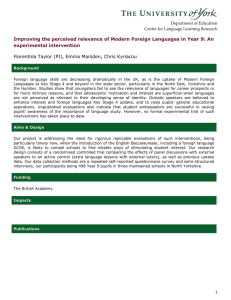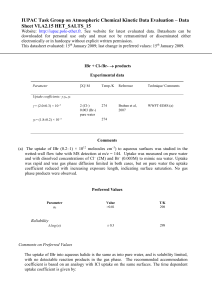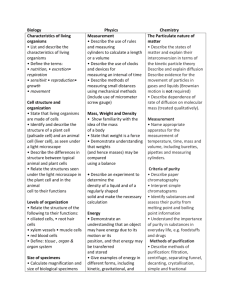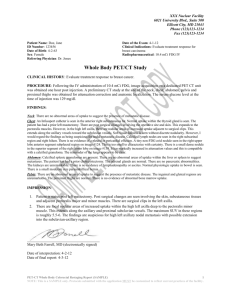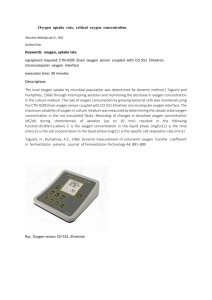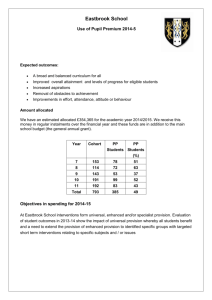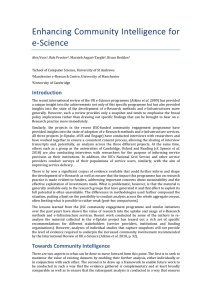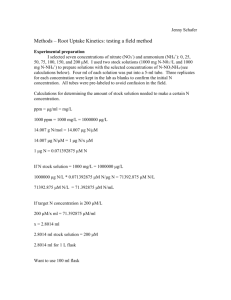This article was published in an Elsevier journal. The attached... is furnished to the author for non-commercial research and
advertisement
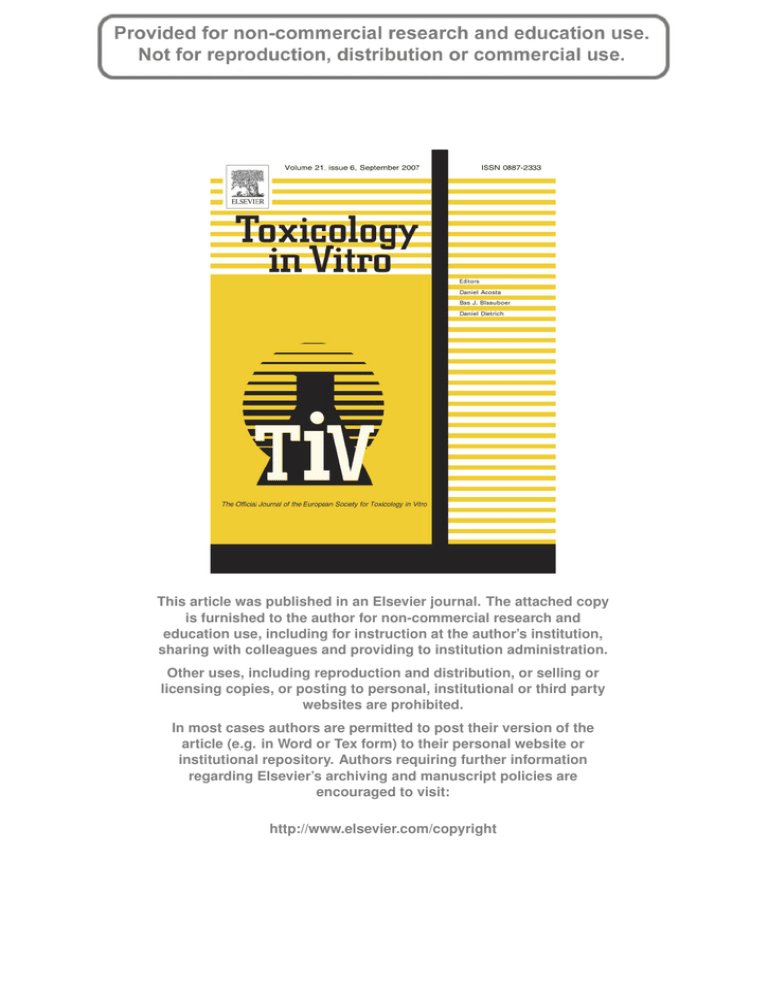
This article was published in an Elsevier journal. The attached copy is furnished to the author for non-commercial research and education use, including for instruction at the author’s institution, sharing with colleagues and providing to institution administration. Other uses, including reproduction and distribution, or selling or licensing copies, or posting to personal, institutional or third party websites are prohibited. In most cases authors are permitted to post their version of the article (e.g. in Word or Tex form) to their personal website or institutional repository. Authors requiring further information regarding Elsevier’s archiving and manuscript policies are encouraged to visit: http://www.elsevier.com/copyright Author's personal copy Toxicology in Vitro 21 (2007) 1077–1086 www.elsevier.com/locate/toxinvit Reciprocal inhibition of Cd and Ca uptake in isolated head kidney cells of rainbow trout (Oncorhynchus mykiss) E. Gagnon a, A. Hontela b, C. Jumarie a a,* Département des sciences biologiques, centre TOXEN, Université du Québec à Montréal, C.P. 8888, Succ. Centre-Ville, Montréal, Québec, Canada H3C 3P8 b Department of Biological Sciences, Water Institute for Semi-arid Ecosystems (WISE), University of Lethbridge, Lethbridge, Alberta, Canada T1K 3M4 Received 4 December 2006; accepted 28 March 2007 Available online 14 April 2007 Abstract Some environmental pollutants, including cadmium (Cd) and zinc (Zn), can act as endocrine disruptors in fish, either in vivo or through a direct action on steroidogenic cells, as has been demonstrated in vitro. We have previously characterized Cd uptake in head kidney (homologue of mammalian adrenal) cells of rainbow trout (Oncorhynchus mykiss) and have provided evidence for a Cd/Ca interaction. Here, we pursued our investigation of metal competition for uptake. Our results show that inorganic speciation conditions favour Cd uptake with optimal level of accumulation for Cd2+ compared to chlorocomplexes (CdCl2n n ). Calcium uptake was studied for the first time in the fish head kidney cells and Ca was found to be less efficiently accumulated compared to Cd. A specific saturable mechanism of transport was characterized for Ca uptake but voltage-gated or La-sensitive cationic channels are unlikely to contribute appreciably. A concentration-dependent reciprocal inhibition was observed between Ca and Cd, whereas, Zn proved to inhibit Cd uptake exclusively. Additive inhibitory effect on Cd uptake was obtained with co-exposure to Ca and Zn. We conclude that Cd, but not Zn, may decrease Ca availability to the head kidney tissue. Also, Zn may partially protect against Cd toxicity but Zn would not protect against Cd-induced perturbation of Ca homeostasis. 2007 Elsevier Ltd. All rights reserved. Keywords: Endocrine disrupters; Adrenal tissue; Cadmium; Zinc; Calcium; Rainbow trout 1. Introduction Cadmium (Cd) is a metal pollutant that can alter the aquatic and terrestrial environment over hundreds of years. Its many industrial uses result in large dispersion throughout ecosystems (reviewed in Pinot et al., 2000). Cd enters the food chain and, because of its long half-life, is concentrated in various organisms. Cd is particularly harmful to teleost fish (reviewed in Sorensen, 1991). Numerous studies reported tissue-specific Cd accumulation following chronic * Corresponding author. Tel.: +1 514 987 3000x7680; fax: +1 514 987 4647. E-mail address: jumarie.catherine@uqam.ca (C. Jumarie). 0887-2333/$ - see front matter 2007 Elsevier Ltd. All rights reserved. doi:10.1016/j.tiv.2007.03.019 exposure in fish (Norey et al., 1990; Hollis et al., 2001; Kraemer et al., 2005). Similar to mammals, Cd uptake in fish elicits protective mechanisms involving binding proteins such as metallothioneins (MT) allowing sequestration to heat-stable proteins subcellular fraction (Chowdhury et al., 2005; Kraemer et al., 2005). Biological detoxification of Cd in fish is closely linked to MT synthesis (Olsson, 1993; Laflamme et al., 2000; Giguere et al., 2006). It is now well recognized that some environmental pollutants, including Cd, can act as endocrine disruptors in fish (Le Guével et al., 2000; Vétillard and Bailhache, 2005). Studies have shown that fish sampled at contaminated sites have an impaired capacity to secrete cortisol, synthesized by steroidogenic cells of the adrenocortical tissue (sometimes also designated as interrenal tissue, located Author's personal copy 1078 E. Gagnon et al. / Toxicology in Vitro 21 (2007) 1077–1086 along with chromaffin and lymphoid cells in the head kidney) (Hontela et al., 1995; Hontela, 1998; Levesque et al., 2002). Although the hypothalamo-pituitary-interrenal axis seems to be an endocrine target of xenobiotics, including Cd (Levesque et al., 2003), it has been shown that Cd may act directly on isolated steroidogenic cells responsible for cortisol secretion in rainbow trout, (Oncorhynchus mykiss) and yellow perch, (Perca flavescens) (Lacroix and Hontela, 2004). Moreover, several studies demonstrated that Cd, as well as zinc (Zn), alter signal transduction pathways leading to cortisol secretion most probably at steps downstream from cAMP formation following stimulation by the adrenocorticotropic hormone (ACTH) (Leblond and Hontela, 1999; Lacroix and Hontela, 2004). Rainbow trout is one of the most sensitive fish species to environmental pollutants and particularly to Cd (Hansen et al., 2002). Indeed, long-term lethal concentrations (LC50) have been estimated to 0.01 mg/l and 0.5 mg/l for trout and perch, respectively, following exposure to Cd in hard water (Alabaster and Lloyd, 1982). Lacroix and Hontela (2004) have further investigated in vitro the differences in Cd sensitivity of steroidogenic cells in the adrenocortical tissue of rainbow trout and yellow perch. Their results showed higher Cd-induced impairment of cortisol secretion in rainbow trout cells compared to yellow perch since 2.8fold higher EC50values (Cd concentration leading to a 50% reduction in cortisol secretion) were obtained for perch cells following a 1 h exposure in vitro (EC50 = 0.09 mM and 0.26 mM for rainbow trout and yellow perch cells, respectively). In mammals, it has been demonstrated that ACTH action is not exclusively mediated by cAMP but also by Ca2+ which plays a key role by close interactions through positive feedback loops enhancing steroid secretion (Gallo-Payet and Payet, 2003). The role of Ca2+ in teleost corticosteroidogenesis has been investigated in vitro using steroidogenic cells in the adrenocortical tissue of rainbow trout: the ACTH-stimulated cortisol secretion was suppressed by the removal of extracellular Ca using EGTA as a chelator (Lacroix and Hontela, 2006). Uptake mechanisms responsible for the cellular accumulation of Cd remain to be identified. The most common hypothesis states that Cd uptake involves competition with essential elements such as Ca or Zn for specific transport systems. In fish, disturbance of plasma Ca2+ levels following exposure to Cd has been linked to direct mechanisms of Cd toxicity. A number of in vivo (Zohouri et al., 2001; Franklin et al., 2005; Reynders et al., 2006) as well as in vitro studies (Verbost et al., 1988; Galvez et al., 2006) have shown reciprocal interaction between waterborne and/or dietary Ca and Cd. A recent study on the effects of Zn pre-exposure on Cd and Zn accumulation in two marine fish species reported that waterborne and dietary Zn exposure increased the metal uptake efficiency from ambient water, but had little effect on dietary metal uptake (Zhang and Wang, 2005). We have recently demonstrated (Raynal et al., 2005) that Cd is highly accumulated in dis- persed head kidney fish cells of rainbow trout and yellow perch with the following characteristics: (i) similar accumulation levels in both species; (ii) the involvement of a specific transport system of high affinity and low capacity in both species; and (iii) higher accumulation levels in the absence of calcium (Ca) in trout but not in yellow perch. However, Ca uptake, as well as how Cd may affect Ca transport, requires further investigations given the important role of Ca in adrenal steroidogenesis and the interactions of Cd and Ca in vivo. Therefore, the aims of our study are: (i) to characterize Ca uptake in the head kidney cells isolated from rainbow trout; (ii) to investigate whether reciprocal inhibitions take place between Cd and Ca for accumulation in these target cells, and (iii) as Zn has also been shown to affect cortisol secretion in vitro (Leblond and Hontela, 1999), to verify whether co-exposure to Cd and Zn results in additive effect on Ca transport. Because metal competition with Ca is expected to involve the free cation (Mz+), uptake experiments were performed under well controlled inorganic speciation conditions and data were analyzed relative to Cd2+and Zn2+ species. Our main hypothesis was that Cd2+, but not Zn2+, may inhibit Ca2+ uptake. 2. Materials and methods 2.1. Chemicals Minimal essential medium (MEM) was obtained from Sigma Chemical Co. (St-Louis, MO). Collagenase/dispase mixture (collagenase from Achromobacter iophagus and dispase from Bacillus polymyxa) came from Boehringer Mannheim (Roche, Basel Switzerland). 3-Aminobenzoic acid ethyl ester (MS 222) for anesthesia was purchased from ICN Pharmaceuticals (Costa Mesa, CA). Filters (pore size: 1.2 lm, Millipore) were purchased from Fisher Scientific (Ottawa, Ontario, Canada). Labeled 109CdCl2(specific activity ranging from 2.6 to 3.8 mCi/mg) and labeled 45 CaCl2 (specific activity ranging from 5 to 50 mCi/mg) were obtained from Perkin–Elmer Life Science (Woodbridge, Ontario, Canada) and Amersham Biosciences Corp. (Piscataway, NJ, USA), respectively. 2.2. Experimental animals Rainbow trout, O. mykiss (body weight 100–150 g) were purchased from Labelle Piscicultures Inc. (Labelle, Quebec, Canada). Upon arrival to our aquatic facilities, fish were maintained in a 600 l freshwater tank at 15 ± 1 C with a constant flow rate of 3.8 l/min of filtered and oxygen-saturated water (hardness 125 mg/l CaCO3). Fish were fed daily with a commercial trout food at the recommended rate (10 g/kg of fish). A two week acclimation period took place before the beginning of the experiments. Fish were handled according to the specification of the Université du Québec Animal Care Committee, following National guidelines. Author's personal copy E. Gagnon et al. / Toxicology in Vitro 21 (2007) 1077–1086 2.3. Preparation of head kidney cell suspension The method described by Leblond et Hontela (1999) was used to prepare the cell suspensions. Fish were anaesthetized with MS222, bled from the caudal vasculature and perfused with a syringe containing saline solution (0,8% NaCl) to remove as much blood as possible. The head kidney was then dissected out and deposited into a tube containing ice-cold MEM supplemented with 5 g/l BSA and 2.2 g/l NaHCO3 (complete medium), pH adjusted to 7.4. The tissue fragments were washed two times with complete medium and resuspended in 3 ml of fresh complete medium containing 2.5 mg/ml collagenase/dispase and incubated for 60 min with gentle agitation at room temperature. The cells were resuspended every 15 min with a transfer pipette. Following enzymatic digestion, the cell suspension was filtered with a 30 lm mesh cloth and the filtrate was washed three times (centrifugation at 300 · g for 5 min at room temperature and resuspension) with a Ringer solution containing (in mM): 111 NaCl, 1.8 CaCl2, 2.7 KCl, 2.4 NaHCO3, 5.5 dextrose, 25 Hepes adjusted to pH 7.4 with 1 mM NaOH. The resulting mixed cell preparations contained chromaffin and immune cells in addition to steroidogenic cells (Hontela, 2005). The total cell suspension was kept in a conical tube (25 ml Sarsted tube) and incubated in the Ringer solution for 1 h with gentle agitation. The cellular density was estimated using an hemacytometer and then adjusted to 5 · 106 cells/ml. Cell preparations from several fishes were then immediately pooled to get sufficient material. Each experiment was performed at least three times with different cell preparations. 2.4. Measurement of Cd and Ca uptake Cd and Ca uptake experiments were performed at room temperature in serum-free transport media referred to as chloride (Cl) and nitrate (NO 3 ) media containing, respectively (in mM): 111 NaCl/NaNO3, 2.7 KCl/KNO3, 1.8 CaCl2/Ca(NO3)2, 2.8 NaHCO3, 5.5 dextrose and 25 Hepes buffered at pH 7.4 with NaOH 1 N. When required, Ca was removed from those media and replaced by Na to maintain osmolarity. The 109Cd at 0.5 lM (0.055 ppm) was added to either the chloride or nitrate transport medium; this concentration does not affect head kidney cell viability (LC50 = 10.8 mM, Leblond and Hontela (1999)). Some experiments were conducted in the presence of increasing concentrations of unlabeled Cd ranging from 0 to 100 lM. The 45Ca at 2.5 lCi/ml was added to uptake media in addition with Ca to get a final total Ca concentration of 0.5 or 5 mM. In some experiments, Ca concentrations ranging from 0.5 to 10 mM were also used. Unless otherwise specified, uptake data are expressed relative to total Ca (45Ca + Ca) and Cd (109Cd + Cd) concentrations. Reciprocal inhibition between Ca and Cd, as well as Zn, was characterized using increasing concentrations of the respective unlabeled metal. Ca uptake was also measured in the presence of 10 lM nifedipine or verapamil (two 1079 well-known voltage-gated Ca channel blockers) or 10 lM lanthanum (La) (blocker for non-selective non-voltagegated Ca channels). Transport media were always prepared in advance and allowed to reach equilibrium overnight in plasticware at room temperature. After specific selected time of incubation, three to five replicates each of 1 ml were sampled from the cell suspension and 50 ll from each replicates were kept for protein determination according to Bradford (1976) using bovine serum albumin as the calibration standard and a Tecan SpectraFluor Plus spectrophotometer (Esbe Scientific Industries Inc., Canada). Samples were then filtered through a single screen vacuum system and rapidly rinsed three times with ice-cold metal-free chloride medium containing 2 mM EDTA to remove the excess radioactivity according to the procedure previously established (Jumarie et al., 2001). Filters were used for radioactivity determination using a gamma counter (Cobra II, Canberra Packard Canada) for 109Cd, and a Wallac 1409 liquid scintillation counter (Wallac Oy, Turku, Finland) for 45Ca. 2.5. Metal speciation and experimental conditions The chemical species of metals in the transport media, namely metal speciation, were identified as previously described (Jumarie et al., 2001) using the MINEQL+ chemical equilibrium program (Schecher and McAvoy, 1994) and the NIST stability constants database (Martell et al., 2001). Because of Cd complexation by Cl, 82% of the total dissolved metal is recovered as CdCln2n species (where n varies from 1 to 3) in a standard chloride medium. Therefore, in most experiments, Cl was changed for NO 3 (which does not bind Cd as much as does Cl) to increase Cd2+ levels relative to chlorocomplex formation (log Kc values for CdCl+ and CdNOþ 3 are 1.98 and 0.50, respectively, where Kc is the formation constant for Cd complexation). This procedure results in a five-fold increase in [Cd2+] (17–84% of the total dissolved metal) (Raynal et al., 2005). Note that NO 3 does not modify membrane permeability (Bergeron and Jumarie, 2006). Also, contrary to Cd, Zn and Ca speciations are not significantly modified by the exposure medium used. Indeed, both Cl and NO 3 have similar and low affinity for both Zn and Ca (log Kc values ranging from 0.4 to 0.6) leading to over 80% of the total dissolved Ca and Zn present as the free cation Ca2+ and Zn2+, respectively. 2.6. Data analysis Uptake time-course data were analyzed according to the first-order rate Eq. (1) U ¼ U max ð1 ekt Þ þ U 0 ð1Þ where U0 and Umax are the uptake values measured at t = 0 (non-zero intercept value) and t = 1 (equilibrium uptake value), respectively, and k representing the time constant of the overall process of accumulation (t1/2 = ln 2/k). Author's personal copy E. Gagnon et al. / Toxicology in Vitro 21 (2007) 1077–1086 The kinetic parameters of Cd and Ca uptake were determined by analyses of the one-time point measurements at 3 min (v3) according to the Michaelis–Menten Eq. (2) ð2Þ in which Km(3) and Vmax(3) have their usual meaning (apparent affinity and maximal velocity of uptake, respectively), [S] stands for the total concentration of Cd or Ca, and kD(3) represents all non-specific contributions to the 3 min uptake data. The initial 3 min uptake values (v3[I]) of Cd and Ca as a function of increasing concentrations of inhibitory metals were analyzed according to Eq. (3), v3ð0Þ v3½I ¼ þ k Dð3Þ ½M; ð3Þ 1 þ K½Ii in which v3(0) stands for the control initial uptake rate (measured in the absence of unlabeled metal), Ki represents the concentration of the inhibitory metal for which halfmaximal inhibition is observed (apparent Ki), [I] represents the concentrations of the unlabeled inhibitory metal, [M] is the concentration of the accumulated metal and kD(3) represents all non-inhibitable uptake components. All uptake experiments were conducted in 3–5 replicates on 3–7 different cell preparations. Nonlinear regression analyses were performed using Prism 3.0 software 2001 (GraphPad Software, San Diego, California, USA). The errors associated with kinetic parameters values given in the text represent the standard errors of nonlinear regression (SER). Statistical significance on the 5-min measurements were performed using a one-way analysis of variance (ANOVA), followed by a Dunnett’s test to compare treated groups with control. Statistical analyses were also done with the two-tailed Student t-test for unpaired data on small samples with Welch’s correction when appropriate. Statistical analyses were performed using InStat software 2001 (GraphPad Software). Statistical significance was assessed at the p < 0.05 level. 3. Results 3.1. Time course of Cd and Ca uptake as a function of the inorganic metal speciation We first estimated how much Cd and Ca accumulated in rainbow trout head kidney cells. Fig. 1a shows the accumulation of 0.5 lM Cd in the inorganic nitrate (filled circles) and the inorganic chloride medium (open circles). The uptake time-course data over a 30 min exposure to Cd in both media were analyzed according to the first-order rate Eq. (1): higher equilibrium accumulation value Umax was obtained in the nitrate medium (0.36 ± 0.12 vs. 0.26 ± 0.08 nmol/mg protein) with comparable t1/2 values (1.5 min). Uptake data measured in the serum-free Cd UPTAKE (nmol/mg protein) V maxð3Þ ½S þ k Dð3Þ ½S; K m þ ½S 0.4 0.04 0.2 0.03 0.02 0.01 0.00 0 5 10 15 20 TIME (min) 0.0 0 5 10 15 20 25 30 TIME (min) 25 20 Ca UPTAKE (nmol/mg protein) v3 ¼ 0.6 Cd UPTAKE (nmol/mg protein) 1080 15 10 5 0 0 10 20 30 40 TIME (min) 50 60 Fig. 1. Time-course of 0.5 lM Cd (a) and 5 mM Ca (b) uptake in head kidney cells of rainbow trout in a nitrate (filled circles) or a chloride medium (open circles). Points shown are means ± SD evaluated on three determinations of the same cell preparation. The lines shown are the bestfit curves over data points as obtained according to Eq. (1). Inset in (a): Time-course of 0.5 lM Cd uptake in the serum-free MEM medium. Data shown are representative of four independent experiments. organic culture medium MEM (inset) revealed much lower levels of Cd accumulation under organic exposure conditions compared to inorganic (either nitrate or chloride). These results suggest the existence of a preferential uptake mechanism for inorganic Cd species and possibly Cd2+ cat ion compared to CdCl2n n . Because changing Cl for NO3 does not significantly modify Ca speciation, the uptaketime course of 5 mM Ca has been studied in a nitrate medium exclusively. Fig. 1b shows that Ca is readily and significantly accumulated in the head kidney cells. Data analyses according to Eq. (1) revealed U0 and Umax values of 9.0 ± 3.1 and 13.2 ± 3.5 nmol/mg protein, respectively, and a t1/2 value around 20 min. Direct comparison between kinetic parameters values obtained for Cd and Ca uptake is difficult because of the much lower Cd level used in our studies. However, it appears clearly that total metal accumulation ratio Author's personal copy E. Gagnon et al. / Toxicology in Vitro 21 (2007) 1077–1086 30 Cd UPTAKE (nmol/3 min/mg protein) (U0 + Umax) for Ca/(U0 + Umax) for Cd of about 40 is much lower than the extracellular concentration ratio ([Ca]/[Cd] of 104), suggesting more efficient processes of accumulation for Cd compared with Ca (i.e., cellular accumulation relative to extracellular level is 250-fold higher for Cd compared to Ca). Indeed, considering an average cell density of 0.4 mg/ml, the Umax values estimated for Cd and Ca accumulation represent total intracellular metal content of 0.14 and 5.3 nmol, respectively, under nitrate exposure conditions. Then, metal depletion from the medium can be estimated to 29% for Cd (0.14 nmol relative to 0.5 nmol – 1 ml of 0.5 lM) but only 0.14% for Ca (5.3 nmol relative to 5000 nmol – 1 ml of 5 mM). 25 20 15 10 5 0 0 25 3.2. Kinetic parameters of Cd and Ca accumulation 50 [Cd] (µM) 75 100 20 Ca UPTAKE (nmol/3 min/mg protein) To further characterize Cd and Ca uptake, we have determined the kinetic parameters of the initial 3-min uptake of Cd (0.5 lM 109Cd + increasing levels of unlabeled Cd ranging from 0 to 100 lM) (Fig. 2a) and Ca (2.5 lCi 45Ca/ml + unlabeled Ca concentrations ranging from 0 to 10 mM) (Fig. 2b) in the nitrate medium optimizing the level of metal cations. Analyses of one-time point measurements according to Eq. (2) gave the following parameter values: Vmax(3) = 16.4 ± 3.7 and 10.9 ± 3.8 nmol/3 min/mg protein; Km = 15.9 ± 5.6 lM and 1.9 ± 0.9 mM; kD(3) = 0.11 ± 0.03 nmol/lM/3 min/mg protein and 0.78 ± 0.28 nmol/mM/3 min/mg protein for Cd and Ca uptake, respectively. Although comparable Vmax values were obtained, much higher affinity was estimated for Cd uptake compared to Ca (two orders of magnitude lower Km value for Cd uptake). The proportionality constant, normalized to 1 mM, of the non-specific uptake was also much higher for Cd (110 vs. 0.8 nmol/3 min/mg protein). However, it is noteworthy that under non-saturating conditions, the contribution of the non-specific component (kD(3) · [S]) to the total accumulation is about 10–15% for both Cd and Ca uptake. 1081 15 10 5 0 0 2 4 6 [Ca] (mM) 8 10 Fig. 2. Determination of kinetic parameters for Cd (a) and Ca (b) uptake in head kidney cells of rainbow trout in a nitrate medium. Initial uptake values were estimated at 3 min using a fixed 109Cd concentration of 0.5 lM and unlabeled Cd concentrations ranging from 0 to 100 lM (a) or 2.5 lCi 45 Ca/ml and unlabeled Ca concentrations ranging from 0 to 10 mM (b). The lines shown are the best-fit curves to Eq. (2). Values shown are means ± SD evaluated on 3 (a) or 4 (b) determinations of the same cell preparation. Data shown are representative of six independent experiments. 3.3. Effects of channel blockers on Ca uptake 3.4. Cd and Ca reciprocal inhibition The impact of Ca channel blockers on the 5-min uptake of Ca has been tested under various experimental conditions using a nitrate exposure medium. As shown in Fig. 3, nifedipine, verapamil as well as lanthanum (La) failed to significantly inhibit Ca uptake, regardless of the presence of Na (filled columns) or the presence of an excess of K (open columns) generally used to induce cellular membrane depolarization which, in turn, activates voltage-sensitive Ca channels. Also, it is noteworthy that slightly higher uptake values were systematically obtained in the standard exposure medium compared to the K medium even in the absence of channel blocker. These results suggest that voltage-gated Ca channels do not contribute appreciably to Ca uptake in head kidney cells of rainbow trout. Also, Ca uptake is unlikely to involve La-sensitive uptake mechanism. Since Cd–Ca interactions for uptake are expected to involve metal cations, these interactions were tested by studying the reciprocal inhibition on the initial 3-min uptake in the nitrate medium. Results obtained for Cd (Fig. 4a) and Ca (Fig. 4b) show a concentration-dependent reciprocal inhibition (filled circles). Data were analyzed according to Eq. (3) with apparent Ki values of 0.9 ± 0.3 mM and 39 ± 11 lM for Cd and Ca uptake, respectively. Therefore, Ca concentration required to lower by half the initial 3-min uptake of only 0.5 lM Cd is 23-fold higher the half-inhibitory concentration of Cd for the 3-min uptake of 0.5 mM Ca. Note that Ca failed to inhibit Cd uptake in the chloride medium where only 17% of Cd is present as Cd2+ (Fig. 3a, open circles), showing that Ca–Cd reciprocal inhibition is Author's personal copy 1082 E. Gagnon et al. / Toxicology in Vitro 21 (2007) 1077–1086 0.5 Cd UPTAKE (nmol/3 min/mg protein) Ca UPTAKE (nmol/5 min/mg protein) 12 * 8 * 4 0 0.4 0.3 0.2 0.1 th an um 0 La n Fig. 3. Short-term (5 min) accumulation of 0.5 mM Ca in head kidney cells of rainbow trout measured in the absence or the presence of 10 lM nifedipine, 10 lM verapamil or 10 lM lanthanum in the nitrate medium. Experiments were conducted in a standard sodium (116 mM Na) (filled columns) or in a Na-free potassium (113 mM K) exposure medium (open columns). In the last case, cell suspensions were also preincubated in the nitrate K medium for 15 min prior to uptake measurements. Values shown are means ± SD evaluated on three independent cell preparations. *Indicates significant differences (p < 0.05) compared to the corresponding Na medium. closely linked to metal speciation. These results suggest specific and exclusive inhibitory process of the uptake of Cd2+ but not CdCl2n n , by Ca. 3.5. Effects of Zn on Cd and Ca uptake Fig. 5a shows that the uptake of 0.5 lM Cd is inhibited by increasing concentrations of Zn but, in accordance with Fig. 1a, accumulation levels were always higher in the nitrate (filled circles) compared to the chloride medium (open circles). The data points obtained in both media were analyzed using Eq. (3) with apparent Ki values of 0.7 ± 0.6 and 2.0 ± 0.9 lM for Cd uptake in the nitrate and the chloride medium, respectively. These results reveal a 2.9-fold higher efficiency for Zn-induced inhibition of Cd uptake in the nitrate medium suggesting optimal inhibition of uptake of the free ion Cd2+. Our results also reveal a 2.6fold higher KD value for Cd uptake in the nitrate medium (0.65 ± 0.03 vs. 0.25 ± 0.02 pmol/lM/5 min/mg protein), suggesting higher component of uptake insensitive to Zn under nitrate exposure conditions. Also, it is noteworthy that the contribution of this insensitive uptake component to the total 5-min accumulation of 0.5 lM Cd is much higher under nitrate exposure conditions compared to chloride (60% vs. 35%). Contrary to what has been observed for Cd uptake, increasing concentrations of Zn failed to modify the uptake of 0.5 mM Ca in a nitrate medium (Fig. 5b). Indeed, any uptake values measured in the presence of Zn were significantly different compared to the control value, suggesting that Zn does not 1 2 3 [Ca] (mM) 4 50 [Cd] (μM) 75 5 15 Ca UPTAKE (nmol/3 min/mg protein) il ap am Ve r ife N C on t di pi n ro l e 0.0 10 5 0 0 25 100 Fig. 4. Short-term (3 min) accumulation of 0.5 lM Cd (a) and 0.5 mM Ca (b) in head kidney cells of rainbow trout in the nitrate (filled circles) or the chloride medium (open circles) as a function of increasing concentrations of Ca (a) or Cd (b). The lines shown are the best-fit curves over data points as obtained according to Eq. (3) with the following apparent constant of inhibition: Ki = 0.9 ± 0.3 mM (a), and Ki= 39 ± 11 lM (b). Points shown are means ± SD evaluated on four determinations of the same cell preparation. Data shown are representative of four independent experiments. interfere with Ca uptake in head kidney cells of the rainbow trout. 3.6. Effects of Zn on Cd and Ca reciprocal inhibition as a function of metal speciation Potential additive inhibitory effects were tested using metal mixtures and results were compared to the inhibitory effect of unlabeled Cd or Ca used as specific inhibitors of 109 Cd and 45Ca uptake, respectively. Therefore, in Figs. 6 and 7 uptake data are expressed relative to tracer exclusively. In accordance with previous results (Fig. 1a), the uptake of 0.5 lM 109Cd was significantly higher in the nitrate medium (filled columns) compared to the chloride medium (open columns) (Fig. 6). It is noteworthy, however, that 100 lM Cd had similar inhibitory effect regard- Author's personal copy E. Gagnon et al. / Toxicology in Vitro 21 (2007) 1077–1086 0.5 0.5 109Cd UPTAKE (nmol/5 min/mg protein) Cd UPTAKE (nmol/5 min/mg protein) 0.6 0.4 0.3 0.2 0.1 1083 δ 0.4 * δb 0.3 *c b 0.2 b 0.1 *c b * δa *a * a *a 0.0 0.0 0 25 50 [Zn] (μM) 75 Ctrl 100 Cd Ca Ca+Cd Zn Ca+Zn 0.5 UPTAKE (nmol/5 min/mg protein) 9 109Cd Ca UPTAKE (nmol/5 min/mg protein) 12 6 0.4 δ *δa 0.3 a 0.2 a a *c *c 0.1 *b 3 0.0 Ctrl 0 0 20 40 60 [Zn] (μM) 80 100 Fig. 5. Short-term (5 min) accumulation of 0.5 lM Cd (a) or 0.5 mM Ca (b) in head kidney cells of rainbow trout in the nitrate (filled circles) or the chloride medium (open circles) as a function of increasing concentrations of Zn. The lines shown are the best-fit curves to Eq. (3) with the following apparent constant of inhibition: Ki = 2.0 ± 1.0 and 0.7 ± 1.1 lM in the chloride and the nitrate medium, respectively (a). Points shown are means ± SD evaluated on four determinations of the same cell preparation. Data shown are representative of three independent experiments. less of the medium used. Considering the Km values estimated at 15 lM (Fig. 2a), 100 lM Cd is expected to completely abolish the specific uptake of 0.5 lM 109Cd; i.e., tracer uptake measured in the presence of 100 lM Cd may be attributed to passive diffusion exclusively, which is similar in both media. In accordance with Fig. 4a, 5 mM Ca failed to inhibit 109Cd uptake in the chloride medium but led to a small but significant 19% decrease when uptake measurements were conducted in the nitrate medium. Following correction of the uptake data for the non-specific component of uptake (Fig. 6b), one may estimate that 5 mM Ca resulted in a 25% inhibition in the specific uptake of 0.5 lM 109Cd in the nitrate medium. Coincubation with Ca and Cd led to similar levels of inhibition compared to Cd alone. Contrary to results shown in Ca Ca+Cd Zn Ca+Zn Fig. 6. Short-term (5 min) total (a) and specific (b) accumulation of 0.5 lM 109Cd Ca/ml in head kidney cells of rainbow trout measured in the chloride (open columns) or the nitrate medium (filled columns), in the absence (Ctrl) or in the presence of 5 mM Ca, 100 lM Cd or 100 lM Zn, added alone or in various combination. Values shown are means ± SD evaluated on three determinations of the same cell preparation. *Significant differences (p 6 0.05) compared with the appropriate control value. d Significant differences (p 6 0.05) compared with chloride medium under the same experimental conditions. Columns labelled with different letters (for the same exposure medium) are significantly different (p = 0.05). Data shown are representative of six independent experiments. Fig. 5a, 100 lM Zn inhibited 109Cd uptake only in the nitrate medium. Zn proved to be more efficient compared to Ca. The presence of Ca did not affect Zn-induced inhibition of 109Cd uptake. In agreement with results in Fig. 2b showing the involvement of a non-specific component in the accumulation of Ca, the uptake of 10 lM 45Ca (2.5 lCi/ml) was highly sensitive to the presence of an excess of 5 mM unlabeled Ca (Fig. 7). However, the non-specific contribution to the total accumulation of 45Ca was higher than estimated in Fig. 2b. Also, in agreement with results shown in Fig. 4b, 100 lM Cd significantly decreased total (Fig. 7a) and specific (Fig. 7b) uptake of 45Ca by 50% and 70%, respectively. Co-incubation with Cd and Ca resulted in a maximal inhibitory effect similar to the Ca-induced inhibition alone. As expected from results shown in Fig. 5b, Zn failed to affect 45 Ca uptake, and alleviated Cd-induced inhibition. Author's personal copy 1084 E. Gagnon et al. / Toxicology in Vitro 21 (2007) 1077–1086 3 45 Ca UPTAKE (nmol/5 min/mg protein) b 2 c ac 1 *a *a 0 Ctrl Ca Cd Ca+Cd Zn Cd+Zn 45 Ca UPTAKE (nmol/5 min/mg protein) 3 2 1 * * 0 Ctrl Cd Ca+Cd Zn Cd+Zn Fig. 7. Short-term (5 min) total (a) and specific (b) accumulation of 5 lM 45 Ca (2.5 lCi/ml) in head kidney cells of rainbow trout measured in the nitrate medium, in the absence (Ctrl) or in the presence of 5 mM Ca, 100 lM Cd or 100 lM Zn, added alone or in various combination. Values shown are means ± SD evaluated on three determinations of the same cell preparation. *Significant differences (p 6 0.05) compared with the control value. Columns labelled with different letters are significantly different (p = 0.05). Data shown are representative of three independent experiments. 4. Discussion In a previous study, we have shown that Cd is readily accumulated in the head kidney cells of rainbow trout with both Cd2+ as well as CdCln2n contributing to metal uptake (Raynal et al., 2005). We now demonstrate that metal speciation significantly affects uptake processes: inorganic speciation conditions favoured both the rate and the level of metal accumulation compared to organic exposure conditions and optimal uptake levels were obtained in a nitrate medium optimizing [Cd2+] over chlorocomplex formation (Fig. 1). The present study, which was conducted at room temperature, reports much higher accumulation levels compared to our previous data obtained at 15 C (Raynal et al., 2005). Although 15 C is expected to be optimal for enzyme and transport activities in teleost fish, differences in uptake levels may be related to temperature variation. This is further supported by the observation of an equilibrium of accumulation reached within minutes in the present study, whereas, accumulation did not plateau for the 1 h exposure period when conducted at 15 C (Raynal et al., 2005). For the first time, we have characterized Ca uptake in isolated head kidney cells of rainbow trout. Similar to Cd, Ca uptake involved a specific mechanism of uptake but accumulation process for Ca appeared less efficient compared to Cd (Fig. 1), with a 120-fold lower affinity (Fig. 2). Although the concentration of Ca used for the time-course experiment exceeded the Km value, the lower accumulation ratio (U0 + Umax/[Ca]) estimated for Ca uptake in Fig. 1 compared to Cd cannot be attributed to saturation, since saturation conditions affect initial uptake rate values (vi) without modifying the equilibrium of uptake. Ca uptake was further studied using various channels blockers. We found Ca uptake to be insensitive to the presence of an excess of extracellular K+ which should readily collapse membrane potential. Also, voltage-gated Ca channels as well as La-sensitive non-specific cationic channels are unlikely to be involved in Ca uptake in head kidney cells of rainbow trout (Fig. 3). However, sufficient data support the involvement of such channels in Ca uptake in steroidogenic cells. Extracellular K+ has been shown to stimulate corticosteroids production in the presence of Ca in bovine fasciculata cells (Yanagibashi et al., 1990). This stimulation was inhibited by nifedipine. Interestingly, the authors failed to reveal similar effect in rat fasciculata cells. Numerous other studies have demonstrated nifedipine- as well as verapamil-inhibited steroidogenesis in bovine adrenocortical cells, suggesting that voltagegated Ca channels are involved in the steroidogenesis of cortisol (Yanagibashi et al., 1990; Burnay et al., 1994; Yamazaki et al., 1998; Dupré-Aucouturier et al., 2002). Using a similar cell preparation as in our study, Lacroix and Hontela (2006) demonstrated that ACTH and pregnenolone (PREG)-stimulated cortisol secretion was inhibited by nicardipine. On the other hand, non-voltage-gated Ca channels may also be involved, since La3+ has been shown to inhibit both cAMP and corticosterone production in isolated bovine adrenal cortex cells in response to ACTH (Haksar et al., 1976; Coyne et al., 1997). In addition, there is some evidence for the involvement of thapsigargine-stimulated store-operated Ca channels in steroidogenesis in bovine adrenocortical fasciculata cells (Ebisawa et al., 2000). Contrary to mammals, steroidogenic cells in fish are dispersed throughout the head kidney which also includes chromaffin and immune cells (Hontela, 2005). Because of the resulting mixed cell preparation, the present data cannot be attributed to steroidogenic cells exclusively, but rather should be interpreted in term of the head kidney, and the adrenocortical tissue as a target organ. Indeed, from a toxicokinetic point of view, metal availability to the adrenal tissue is relevant and for the first time, we show reciprocal inhibition between Cd and Ca for accumulation in this target tissue (Fig. 4). Moreover, our speciation studies reveal the exclusive involvement of the free cation Cd2+ in this inhibitory process: clearly Cd2+ is able to modify Author's personal copy E. Gagnon et al. / Toxicology in Vitro 21 (2007) 1077–1086 Ca2+ uptake through cationic channels. Therefore, Cd may lower Ca availability to the steroidogenic cells. Whether this lower availability may result in an impaired cortisol secretion needs to be verified. However, Cd has already been shown to decrease in vitro cortisol secretion in similar cell preparation of the head kidney of rainbow trout (Leblond and Hontela, 1999). Also, the adrenotoxic effect of Cd in these cells was increased in the absence of extracellular Ca but was prevented in media supplemented with Ca (Lacroix and Hontela, 2006). Moreover, cell treatment with BAY K8644, an agonist of voltage-gated Ca channels, increased the inhibitory effect of Cd on ACTH-stimulated cortisol secretion as well as on Cd-induced cell mortality (Lacroix and Hontela, 2006). Regardless of the Cd–Ca competition for uptake in the steroidogenic cells per se, significant lower Ca availability to the head kidney tissue is expected to affect Ca uptake in the steroidogenic cells. It is noteworthy that Cd would not completely abolish Ca accumulation because of the non-inhibitable component of Ca uptake (related to parameter kD in Eqs. (2) and (3)). Similar conclusion holds for the inhibition of Cd uptake by Ca. In addition to Cd, Zn has also been shown to impair cortisol secretion in adrenortical cells of rainbow trout in vitro (Leblond and Hontela, 1999). Here we show that, contrary to Cd, Zn does not affect Ca uptake in these cells (Fig. 5). Zn is an essential element and Zn uptake through Ca channel has never been reported. Therefore, Cd, but not Zn, could affect Ca homeostasis in the head kidney tissue of rainbow trout. However, Zn did inhibit partially Cd uptake; the component of Cd accumulation sensitive to Zn may be related to transport mechanism insensitive to Ca. This conclusion is further supported by the observation of additional effect of Zn on Cainduced inhibition of Cd uptake (Fig. 6). On the other hand, how Zn may affect Cd uptake clearly deserves further investigation. In conclusion, we have demonstrated that Cd uptake in head kidney cells of rainbow trout is optimal under inorganic speciation conditions. For the first time, our results reveal that Cd, but not Zn, may decrease Ca availability to the head kidney tissue. They also demonstrate that Zn may partially protect against Cd toxicity by lowering Cd accumulation. However, because Zn and Ca seem to affect different components of Cd uptake, Zn would not necessarily protect against Cd-induced perturbation of Ca homeostasis. The data from this study using primary culture of the rainbow trout head kidney cells provide new understanding of the mechanisms that might mediate metalinduced disruption of steroidogenesis in adrenal tissues in vivo. Acknowledgements This research was supported by the Canadian Network of Toxicology Centres (CNTC) and Metals In The Human Environment – Research Network (MITHE – RN) as well 1085 as by Discovery Grants of the Natural Sciences and Engineering Research Council of Canada (NSERC). References Alabaster, J.S., Lloyd, R., 1982. Water Quality Criteria for Freshwater Fish. Butterworths, London. Bergeron, P.M., Jumarie, C., 2006. Characterization of cadmium uptake in human intestinal crypt cells HIEC in relation to inorganic metals speciation. Toxicology 219, 156–166. Bradford, M.M., 1976. A rapid and sensitive method for the quantitation of microgram quantities of protein utilizing the principle of protein– dye binding. Analytical Biochemistry 72, 248–254. Burnay, M., Python, C.P., Vallotton, M.B., Capponi, A.M., Rossier, M.F., 1994. Role of the capacitative calcium influx in activation of steroidogenesis by angiotensin-II in adrenal glomerulosa cells. Endocrinology 135, 751–758. Chowdhury, M.J., Baldisserotto, B., Wood, C.M., 2005. Tissue-specific cadmium and metallothionein levels in rainbow trout chronically acclimated to waterborne or dietary cadmium. Archives in Environmental Contamination and Toxicology 48, 381–390. Coyne, M.D., Rodriguez, O., Wilson, Y., Wang, G., Lemos, J.R., 1997. Voltage dependent calcium and potassium currents in Y-1 adrenocortical cells are unresponsive to ACTH. Endocrine Research 23, 245–275. Dupré-Aucouturier, S., Penhoat, A., Rougier, O., Bilbaut, A., 2002. ACTH-induced Cl() current in bovine adrenocortical cells: correlation with cortisol secretion. American Journal of Physiology and Endocrinology Metabolism 282, E355–E365. Ebisawa, T., Kondo, I., Masaki, E., Hori, S., Kawamura, M., 2000. Capacitative calcium entry is involved in steroidogenesis in bovine adrenocortical fasciculata cells. Journal of Endocrinology 167, 473–478. Franklin, N.M., Glover, C.N., Nicol, J.A., Wood, C.M., 2005. Calcium/ cadmium interactions at uptake surfaces in rainbow trout: Waterborne versus dietary routes of exposure. Environmental Toxicology and Chemistry 24, 2954–2964. Gallo-Payet, N., Payet, M.D., 2003. Mechanism of action of ACTH: Beyond cAMP. Microscopy Research and Technique 61, 1–12. Galvez, F., Wong, D., Wood, C.M., 2006. Cadmium and calcium uptake in isolated mitochondria-rich cell populations from the gills of the freshwater rainbow trout. American Journal of Physiology. Regulatory, Integrative and Comparative Physiology 291, R170– R176. Giguere, A., Campbell, P.G.C., Hare, L., Couture, P., 2006. Sub-cellular partitioning of cadmium, copper, nickel and zinc in indigenous yellow perch (Perca flavescens) sampled along a polymetallic gradient. Aquatic Toxicology 77, 178–189. Haksar, A., Maudsley, D.V., Peron, F.G., Bedigian, E., 1976. Lanthanum: Inhibition of ACTH-stimulated cyclic AMP and corticosterone synthesis in isolated rat adrenocortical cells. Journal of Cell Biology 68, 142–153. Hansen, J.A., Welsh, P.G., Lipton, J., Cacela, D., Dailey, A.D., 2002. Relative sensitivity of Bull trout (Salvelinus confluentus) and Rainbow trout (Oncorhynchus mykiss) to acute exposures of cadmium and zinc. Environmental Toxicology and Chemistry 21, 67–75. Hollis, L., Hogstrand, C., Wood, C.M., 2001. Tissue-specific cadmium accumulation, metallothionein induction, and tissue zinc and Copper levels during chronic sublethal cadmium exposure in juvenile rainbow trout. Archives of Environmental, Contamination and Toxicology 41, 468–474. Hontela, A., 1998. Interrenal dysfunction in fish from contaminated sites: in vivo and in vitro assessment. Environmental Toxicology and Chemistry, Annual Review 17, 44–48. Hontela, A., 2005. Adrenal toxicology: Environmental pollutants and the HPI-axis. Chapter 12. In: Mommsen, T.P., Moon, T.W. (Eds.), Biochemistry and Molecular Biology of Fishes, vol. 6, Environmental Toxicology. pp. 331–363. Author's personal copy 1086 E. Gagnon et al. / Toxicology in Vitro 21 (2007) 1077–1086 Hontela, A., Dumont, P., Duclos, D., Fortin, R., 1995. Endocrine and metabolic dysfunction in yellow perch, Perca flavescens, exposed to organic contaminants and heavy metals in the St. Lawrence river. Environmental Toxicology and Chemistry 14, 725–731. Jumarie, C., Fortin, C., Houde, M., Campbell, P.G.C., Denizeau, F., 2001. Cadmium uptake by Caco-2 Cells: Effects of Cd complexation by chloride, glutathione and phytochelatins. Toxicology and Applied Pharmacology 170, 29–38. Kraemer, L.D., Campbell, P.G., Hare, L., 2005. Dynamics of Cd, Cu and Zn accumulation in organs and sub-cellular fractions in field transplanted juvenile yellow perch (Perca flavescens). Environmental Pollution 138, 324–337. Lacroix, A., Hontela, A., 2004. A comparative assessment of the adrenotoxic effects of cadmium in two teleost species, rainbow trout, Oncorhynchus mykiss and yellow perch, Perca flavescens. Aquatic Toxicology 67, 13–21. Lacroix, A., Hontela, A., 2006. Role of calcium channels in cadmiuminduced disruption of cortisol synthesis in rainbow trout (Oncorhynchus mykiss). Comparative Biochemistry and Physiology. Part C. doi:10.1016/j.cbpc.2006.07.008. Laflamme, J.S., Couillard, Y., Campbell, P.G.C., Hontela, A., 2000. Interrenal metallothionein and cortisol secretion in relation to Cd, Cu, and Zn exposure in yellow perch, Perca flavescens, from Abitibi lakes. Canadian Journal of Fish and Aquatic Sciences 57, 1692–1700. Leblond, V., Hontela, A., 1999. Effects of in vitro exposures to cadmium, mercury, zinc and 1-(2-chlorophenyl)-1-(4-chlorophenyl)-2,2-dichloroethane on steroidogenesis by dispersed interrenal cells of rainbow trout (Oncorhynchus mykiss). Toxicology and Applied Pharmacology 157, 16–22. Le Guével, R., Petit, F.G., Le Goff, P., Métivier, R., Valotaire, Y., Pakdel, F., 2000. Inhibition of rainbow trout (Oncorhynchus mykiss) estrogen receptor activity by Cadmium. Biology of Reproduction 63, 259–266. Levesque, H.M., Moon, T.W., Campbell, P.G.C., Hontela, A., 2002. Seasonal variation in carbohydrate and lipid metabolism of yellow perch (Perca flavescens) chronically exposed to metals in the field. Aquatic Toxicology 60, 257–267. Levesque, H.M., Dorval, J., Hontela, A., Van Der Kraak, G.J., Campbell, P.G.C., 2003. Hormonal, morphological, and physiological responses of yellow perch (Perca flavescens) to chronic environmental metal exposures. Journal of Toxicology and Environmental Health 66, 657–676. Martell, A.E., Smith, R.M., Motekaitis, R.J., 2001. NIST Standard Reference Database 46. Critically selected stability constants of metal complexes. US Department of Commerce, Gaithersbrug, MD. Version 6.0. Norey, C.G., Brown, M.W., Cryer, A., Kay, J., 1990. A comparison of the accumulation, tissue distribution and secretion of cadmium in different species of freshwater fish. Comparative Biochemistry and Physiology. Part C. 96, 181–184. Olsson, P.E., 1993. Metallothionein gene expression and regulation in fish. In: Hochachka, Mommsen (Eds.), Biochemistry and Molecular Biology of Fishes, vol. 2. Elsevier Science Publishers B.V., pp. 259– 278. Pinot, F., Kreps, S.E., Bachelet, M., Hainaut, P., Bakonyi, M., Polla, B.S., 2000. Cadmium in the environment: Sources, mechanisms of biotoxicity, and biomarkers. Reviews on Environmental Health 15, 299–323. Raynal, N.J., Hontela, A., Jumarie, C., 2005. Cadmium uptake in isolated adrenocortical cells of rainbow trout and yellow perch. Comparative Biochemistry and Physiology Part C 140, 374–382. Reynders, H., Van Campenhout, K., Bervoets, L., De Coen, W.M., Blust, R., 2006. Dynamics of cadmium accumulation and effects in common carp (Cyprinus carpio) during simultaneous exposure to water and food (Tubifex tubifex). Environmental Toxicology and Chemistry 25, 1558– 1567. Schecher, W.D., McAvoy, D., 1994. MINEQL+: A chemical equilibrium program for personal computers, version 3.01. Environ. Research Software, Hallowell, ME. Sorensen, E.M., 1991. Cadmium. Metal Poisoning in Fish. CRC Press, Boca Raton, Florida, USA, pp. 75–234. Verbost, P.M., Flik, G., Lock, R.A.C., Wendelaar Bonga, S.E., 1988. Cadmium inhibits plasma membrane calcium transport. Journal of Membrane Biology 102, 97–104. Vétillard, A., Bailhache, T., 2005. Cadmium: An endocrine disrupter that affects gene expression in the liver and brain of juvenile rainbow trout. Biology of Reproduction 72, 119–126. Yamazaki, T., Kimoto, T., Higuchi, K., Ohta, Y., Kawato, S., Kominami, S., 1998. Calcium ion as a second messager for o-nitrophenylsulfenyladrenocorticotropin (NPS-ACTH) and ACTH in bovine adrenal steroidogenesis. Endocrinology 139, 4765–4771. Yanagibashi, K., Kawamura, M., Hall, P.F., 1990. Voltage-dependent Ca2+ channels are involved in regulation of steroid synthesis by bovine but not rat fasciculata cells. Endocrinology 127, 311–318. Zhang, L., Wang, W.X., 2005. Effects of Zn pre-exposure on Cd and Zn bioaccumulation and metallothionein levels in two species of marine fish. Aquatic Toxicology 73, 353–369. Zohouri, M.A., Pyle, G.G., Wood, C.M., 2001. Dietary Ca inhibits waterborne Cd uptake in Cd-exposed rainbow trout, Oncorhynchus mykiss. Comparative Biochemistry and Physiology, Toxicology and Pharmacology 130, 347–356.
